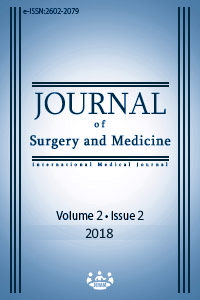Intensity-modulated radiation therapy reduces late salivary toxicity and mandibular osteoradionecrosis in the treatment of oral cavity cancer: Retrospective study
Keywords:
Intensive modulated radiotherapy, Oral cavity cancer, Xerostomia, Mandibular osteoradionecrosisAbstract
Aim: It is increasingly being recognized that oral cavity cancer incidences are rising globally. Irradiation using 3D conformal radiotherapy results in high incidence of late radiation side-effects. Xerostomia and manibudlar osteoradionecrosis result in most significant effects on patients quality of life. Intensive modulated radiotherapy (IMRT) is an advanced approach to 3D treatment planning and conformal radiotherapy. It optimizes the delivery of irradiation to irregularly-shaped volumes and has the ability to spare normal tissue while delivering adequate doses to the tumor volumes. In present retrospective analysis, we aimed to analyze the clinical and dosimetric characteristics with the dose constraints in patients followed for oral cavity cancer and treated by IMRT.
Methods: 19 patients followed for non-metastatic oral cavity cancer who were treated with IMRT, were retrospectively analyzed at the radiotherapy department Hassan II University hospital, Fes, Morocco between January 2016 and December 2016.
Results: The mean age was 58.5 years. The predominant histological type was epidermoid carcinoma. RCC was received in 79% of cases versus 15.8% of exclusive radiotherapy. 68.4% of cases received 70Gy for HR PTV, the mean dose delivered to the homolateral and controlateral parotid glands was 36Gy and 22Gy respectively, the average dose delivered to the mandible was 51.9Gy.
Conclusion: IMRT of oral cavity tumors offers reduces the risks of xerostomia and ORN through parotid and mandibular sparing, without compromising on target volume coverage.
Downloads
References
Moore SR, Johnson NW, Pierce AM, Wilson DF. The epidemiology of mouth cancer: A review of global incidence. Oral Dis. 2000;6:65-74.
Campaign TC. CRC Cancer Stats, Oral UK. London: CRC; 2000.
Sunny L, Yeole BB, Hakama M, Shiri R, Sastry PS, Mathews S, et al. Oral cancers in Mumbai, India: A fifteen years perspective with respect to incidence trend and cumulative risk. Asian Pac J Cancer Prev. 2004;5:294-300.
IARC. Tobacco Habits other than Smoking; Betel-quid and Areca-nut Chewing, and Some Related Nitrosamines. Lyon: International Agency for Research on Cancer; 1985.
Kademani D, Bell RB, Bagheri S, Holmgren E, Dierks E, Potter B, et al. Prognostic factors in intraoral squamous cell carcinoma: The influence of histologic grade. J Oral Maxillofac Surg. 2005;63:1599-605.
Spiro RH, Huvos AG, Wong GY, Spiro JD, Gnecco CA, Strong EW. Predictive value of tumor thickness in squamous carcinoma confined to the tongue and floor of the mouth. Am J Surg. 1986;152:345-50.
Results of a prospective trial on elective modified radical classical versus supraomohyoid neck dissection in the management of oral squamous carcinoma. Brazilian Head and Neck Cancer Study Group. Am J Surg. 1998;176:422-7.
Shah JP, Candela FC, Poddar AK. The patterns of cervical lymph node metastases from squamous carcinoma of the oral cavity. Cancer. 1990;66:109-13.
Peters LJ, Goepfert H, Ang KK, Byers RM, Maor MH, Guillamondegui O, et al. Evaluation of the dose for postoperative radiation therapy of head and neck cancer: First report of a prospective randomized trial. Int J Radiat Oncol Biol Phys. 1993;26:3-11.
Chao KS, Deasy JO, Markman J, Haynie J, Perez CA, Purdy JA, et al. A prospective study of salivary function sparing in patients with head-and-neck cancers receiving intensity-modulated or threedimensional radiation therapy: Initial results. Int J Radiat Oncol Biol Phys 2001;49:907-16.
Eisbruch A, Marsh LH, Martel MK, Ship JA, Ten Haken R, Pu AT, et al. Comprehensive irradiation of head and neck cancer using conformal multisegmental fields: Assessment of target coverage and noninvolved tissue sparing. Int J Radiat Oncol Biol Phys. 1998;41:559-68.
Butler EB, Teh BS, Grant WH 3rd, Uhl BM, Kuppersmith RB, Chiu JK, et al. Smart (simultaneous modulated accelerated radiation therapy) boost: A new accelerated fractionation schedule for the treatment of head and neck cancer with intensity modulated radiotherapy. Int J Radiat Oncol Biol Phys. 1999;45:21-32.
Eisbruch A, Ten Haken RK, Kim HM, Marsh LH, Ship JA. Dose, volume, and function relationships in parotid salivary glands following conformal and intensity-modulated irradiation of head and neck cancer. Int J Radiat Oncol Biol Phys. 1999;45:577–87.
Nutting CM, Morden JP, Harrington KJ, Urbano TG, Bhide SA, Clark C, et al. Parotid-sparing intensity modulated versus conventional radiotherapy in head and neck cancer (PARSPORT): a phase 3 multicentre randomised controlled trial. Lancet Oncol. 2011;12:127–36.
Gomez DR, Estilo CL, Wolden SL, Zelefsky MJ, Kraus DH, Wong, et al. Correlation of osteoradionecrosis and dental events with dosimetric parameters in intensity-modulated radiation therapy for head-and-neck cancer. Int J Radiat Oncol Biol Phys. 2011;81:e207–13.
Cooper JS, Fu K, Marks J, Silverman S. Late effects of radiation therapy in the head and neck region. Int J Radiat Oncol Biol Phys. 1995;31:1141–64
Downloads
- 1857 2054
Published
Issue
Section
How to Cite
License
Copyright (c) 2018 Terrab Fatima Zahrae, Allouche Fadwa, El Mazghi Abderrahmane, Bouhafa Touria, Hassouni Khalid
This work is licensed under a Creative Commons Attribution-NonCommercial-NoDerivatives 4.0 International License.















